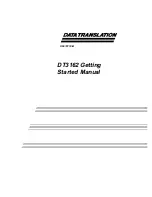
4-6 Chapter
4
Antialiasing settings:
Use this slider by dragging it to set the degree of
antialiasing to be used in Direct3D and OpenGL applications.
Antialiasing
is
a technique used to minimize the "stairstep" effect sometimes seen along the
edges of 3D objects. Your selection can range from turning antialiasing
completely off to selecting the maximum amount possible for a particular
application.
NOTE:
Availability of options described in this section may depend on the
NVIDIA GPU you are using.
Off:
This option will disable antialiasing in 3D applications. Select this option
if you require maximum performance in your applications.
2x:
This option will enable antialiasing using the 2x mode. It offers improved
image quality and high performance in 3D applications.
2xQ:
This option enables a patented antialiasing technique available in the
GeForce GPU family. 2xQ antialiasing offers the quality of the slower, 4x
antialiasing mode at nearly the performance of the faster, 2x mode.
4x:
This option will enable antialiasing using the 4x mode. It offers the higher
image quality at the expense of some performance in 3D applications.
6x:
This option enables antialiasing using the 6x mode. It offers higher image
quality than 4x mode. This setting affects only Direct3D applications.
8x:
This option will enable antialiasing using the 8x mode. It offers higher
image quality than 6x mode for Direct3D applications and 4x mode for
OpenGL applications.
Anisotropic filtering:
Use this slider by dragging it to set the degree of
anisotropic filtering for improved image quality. Enabling this option
improves image quality at the cost of performance.
NOTE:
Availability of options described in this section may depend on the
NVIDIA GPU you are using.
Off:
Disables anisotropic filtering.
2x:
Results in improved image quality at the cost of performance.
4x:
Results in improved image quality at the cost of performance.
8x:
Results in best image quality.
Siluro FX Series
Summary of Contents for SILURO FX Series
Page 5: ...1 User s Manual...
Page 12: ...8 AGP 1 2 3 4 5 6 7 AGP AGP AGP VGA Siluro FX Series...
Page 13: ...9 VGA 1 2 3 Standard VGA VGA 2 2 Driver 3 User s Manual...
Page 14: ...10 AGP 1 2 3 4 5 6 7 AGP AGP AGP 1 2 3 VGA PC 2 2 Siluro FX Series...
Page 15: ...11 Driver 3 User s Manual...
Page 16: ...12 AGP 1 2 3 4 5 6 7 AGP AGP AGP VGA VGA 1 2 3 VGA VGA PC 2 2 Siluro FX Series...
Page 17: ...13 3 User s Manual...
Page 18: ...14 AGP 1 2 3 4 5 6 7 AGP AGP AGP VGA Siluro FX Series...
Page 19: ...15 VGA 1 2 3 VGA VGA PC 2 2 Driver 3 User s Manual...
Page 20: ...16 AGP 1 2 3 4 5 6 7 AGP AGP AGP VGA Siluro FX Series...
Page 21: ...17 VGA 1 2 3 VGA VGA PC 2 2 Driver 3 User s Manual...
Page 22: ...18 18 Siluro FX Series Siluro FX Series...
Page 32: ...1 10 Chapter 1 Siluro FX Series...
Page 34: ...2 2 Chapter 2 2 2 Devices Connection Siluro FX5900 OTES 128MB Siluro FX Series...
Page 35: ...Hardware Setup 2 3 Siluro FX5600 Ultra OTES User s Manual...
Page 36: ...2 4 Chapter 2 Siluro FX5600 OTES Siluro FX Series...
Page 37: ...Hardware Setup 2 5 Siluro FX5200 OTES User s Manual...
Page 38: ...2 6 Chapter 2 Siluro FX5700 Ultra Siluro FX Series...
Page 39: ...Hardware Setup 2 7 Siluro FX5700 FX5700 E FX5700 L User s Manual...
Page 40: ...2 8 Chapter 2 Siluro FX5600 Ultra DT Siluro FX Series...
Page 41: ...Hardware Setup 2 9 Siluro FX5600 DT FX5200 DT User s Manual...
Page 42: ...2 10 Chapter 2 Siluro FX5600XT Siluro FX Series...
Page 44: ...2 12 Chapter 2 2 12 Chapter 2 Siluro FX Series Siluro FX Series...
















































